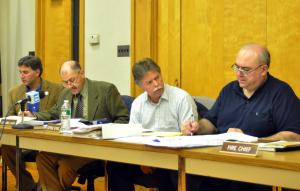Rare blood disorder
http://www.tnonline.com/node/147135
Rare blood disorder
Study will look at air and water quality
Reported on Friday, October 29, 2010
By DONALD R. SERFASS dserfass@tnonline.com
 DONALD R. SERFASS/TIMES NEWS Members of the Tri-County Polycythemia Vera Citizens Advistory Committee pose questions late Thursday to experts who will study the local air and water quality. From left: CAC chairman and Tamaqua Mayor Chris Morrison; Mark Ioos, vice president, Skelly and Loy, Harrisburg; Peter Jaran, engineer, Equity Environmental Engineering, Flanders, NJ; and Joe Murphy, CAC member.
DONALD R. SERFASS/TIMES NEWS Members of the Tri-County Polycythemia Vera Citizens Advistory Committee pose questions late Thursday to experts who will study the local air and water quality. From left: CAC chairman and Tamaqua Mayor Chris Morrison; Mark Ioos, vice president, Skelly and Loy, Harrisburg; Peter Jaran, engineer, Equity Environmental Engineering, Flanders, NJ; and Joe Murphy, CAC member.
A New Jersey firm will oversee a regional air and water quality study to try and find out why there is a higher then normal incidence of a rare blood disease in the local area.
The study, the first of a multifaceted investigation, comes about after cases of polycythemia vera, a rare blood cancer, have surfaced in clusters at an unusually high rate in Carbon, Schuylkill and Luzerne counties.
Peter Jaran of Equity Environmental Engineering, Flanders, N.J., will serve as project manager and will employ the expertise of a project team to include Skelly & Loy, an environmental consulting firm in Harrisburg; and Princeton Somerset Group, a firm headed by Dr. Dennis M. Stainken, providing expertise in the field of toxicology, health issues, chemical exposures, contamination and other issues.
 DONALD R. SERFASS/TIMES NEWS “This is very personal to the community. We need to have open lines of communication,” says Peter Jaran, left, on Thursday at Tamaqua Borough Hall. Jaran, an environmental engineer from New Jersey, will serve as project manager in an air and water quality study as part of an investigation into a rare blood disorder that surfaced two years ago in Carbon, Schuylkill and Luzerne counties. Shown right is Joe Murphy, Hometown, of the Citizens Advisory Committee.
DONALD R. SERFASS/TIMES NEWS “This is very personal to the community. We need to have open lines of communication,” says Peter Jaran, left, on Thursday at Tamaqua Borough Hall. Jaran, an environmental engineer from New Jersey, will serve as project manager in an air and water quality study as part of an investigation into a rare blood disorder that surfaced two years ago in Carbon, Schuylkill and Luzerne counties. Shown right is Joe Murphy, Hometown, of the Citizens Advisory Committee.
The study will be funded through part of the $8M earmarked by Sen. Arlen Specter.
“We were awarded the contract with the Centers for Disease Control (CDC) at the end of September,” said Jaran.
On Thursday, members of the Tri-County Polycythemia Vera Community Advisory Committee (CAC) took Jaran and Mark B. Ioos, vice president, Skelly and Loy, on a tour of the local area. The session was followed by a meeting at Tamaqua Borough Hall in which Jaran outlined the course of action and answered questions posed by CAC members. Tamaqua Mayor Chris Morrison serves as chairman of the CAC and moderated the session.
The goal of the assessment is to identify possible contributing factors of the PV cases and related myeloproliferative diseases (MPDs) and their possible link to environmental conditions in the area.
The discussion mentioned factors such as the presence of Superfund sites in the area, along with fly ash trucking and storage, and a wide variety of other industries such as co-gen plants, gas plants and manufacturers, and even the existing fluff pile in Hometown.
“We were originally looking at the drinking water,” revealed Jaran, noting that “the first step is that we have to take a look at the (existing) data. How does each one of the environmental aspects impact the human body.”
Hydrogeology has been identified as task one of the project, followed by air pollution exposure assessment. Air assessment will evaluate present and past exposures of cluster-area residents to specific air pollutants, including factors such as topography and air emission. Task three will focus on community interaction, including a working relationship with the CAC.
“This is very personal to the community,” said Jaran. “We need to have open lines of communication.”
That view was echoed by Morrison, who stressed the importance of timely dissemination of information to the public.
CAC members posed a wide variety of questions to Jaran and Ioos. For example, Hometown resident Joe Murphy, longtime advocate for a health and environment, asked Jaran if his firm or any of its clients might be seen as having a conflict of interest regarding aspects of the local study, including its outcome. Jaran said no, explaining that the potential issue already had been explored at Equity Environmental Engineering.
The air and water assessment study and other related studies will extend through 2011 and 2012.
During the business portion of the meeting, CAC members approved a request to the CDC and the Agency for Toxic Substances and Disease Registry for $25,000 in operational funding for both years.
Other studies are forthcoming. For example, Drexel University investigators will use a case control study to try and determine factors that may contribute to the PV cluster in the Tamaqua-Hazleton area by examining environmental and occupational histories of patients with PV and MPD-related disease and comparing them with those free of the diseases.
A University of Pittsburgh team will conduct a study that will compare PV rates in the Tamaqua-Hazleton area to those in four counties in the western Pennsylvania coal region to look for similarities and differences in the two areas that might provide clues to the causes of the disease.
